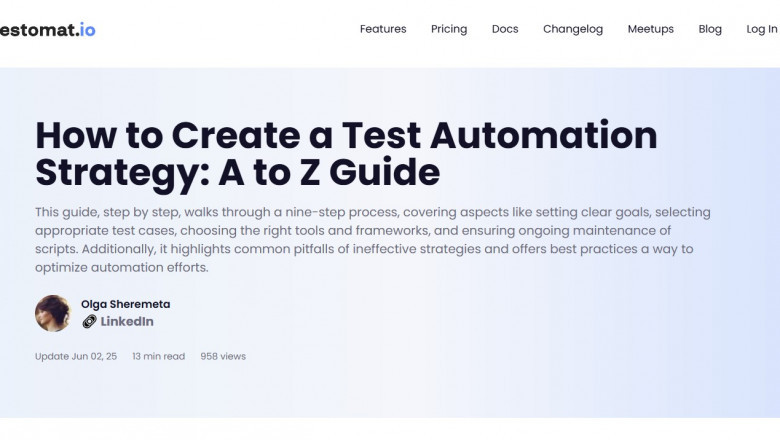views
How to Build a Successful Automation Testing Strategy for Your Projects
In today’s fast-paced software development environment, automation testing has become an essential part of delivering high-quality products efficiently. But to harness the full power of automated testing, you need a well-thought-out automation testing strategy. Without it, automation efforts may become chaotic, costly, and ineffective, leading to wasted resources and missed deadlines.
If you’re looking to understand how to create an automation testing strategy that aligns with your project goals and maximizes test coverage, the guide at https://testomat.io/blog/how-to-create-a-test-automation-strategy-guide/ is an invaluable resource. This comprehensive article dives deep into the steps, best practices, and tips for crafting a successful strategy tailored to your team and product.
Why You Need an Automation Testing Strategy
Automation testing is not just about writing scripts that run tests automatically. It’s a strategic approach that involves deciding what to automate, how to automate, when to automate, and how to maintain automation efficiently. A solid automation testing strategy ensures your efforts bring tangible benefits like faster feedback, higher test reliability, and reduced manual workload.
Without a clear strategy, teams often face challenges such as flaky tests, low test coverage, difficult maintenance, and inefficient use of automation tools. This guide helps you avoid these pitfalls by offering a structured framework for your automation initiatives.
Core Components of a Strong Automation Testing Strategy
Building an effective automation testing strategy involves several key components that the guide at Testomat.io outlines in detail:
-
Goal Definition: Establish clear objectives for automation based on project needs. Whether it’s speeding up regression testing, improving test accuracy, or enabling continuous integration, knowing your goals guides your entire strategy.
-
Test Selection: Decide which tests to automate. Prioritize stable, repeatable test cases with high impact, such as regression tests and critical user flows. The guide explains how to identify these tests effectively.
-
Tool Selection: Choosing the right automation tools is crucial. The guide reviews popular frameworks and tools, helping you select one that fits your technology stack, team skills, and project complexity.
-
Test Design: Writing maintainable and reliable automated tests requires good design principles. You will learn about test modularity, data-driven testing, and ways to reduce flakiness.
-
Execution Strategy: Plan how and when automated tests will run. Integrating tests into your CI/CD pipeline ensures quick feedback and smooth deployments.
-
Maintenance Plan: Automation tests need regular updates to stay effective. The guide stresses the importance of ongoing maintenance and offers tips on managing test code and test data.
-
Metrics and Reporting: Measuring the success of your automation efforts is vital. You’ll discover useful metrics to track progress and identify improvement areas.
Benefits of Following a Proven Automation Testing Strategy
By following the practical advice and framework provided in the automation testing strategy guide, teams gain numerous benefits, including:
-
Improved Test Coverage: Automation helps cover more test scenarios consistently.
-
Faster Feedback Loops: Automated tests run quickly and frequently, enabling rapid defect detection.
-
Reduced Manual Testing Efforts: Manual testers can focus on exploratory testing and complex scenarios.
-
Increased Product Quality: Consistent regression checks ensure product stability after changes.
-
Cost Efficiency: Well-maintained automation reduces long-term testing costs.
Who Will Benefit Most From This Guide?
Whether you are a QA engineer, test lead, project manager, or developer, understanding how to create and implement a robust automation testing strategy will enhance your testing process. The guide is also beneficial for startups and enterprises aiming to scale their testing efforts without compromising quality.
Learn From Real-World Examples and Best Practices
The article doesn’t stop at theory — it provides practical examples and actionable best practices drawn from industry experience. You’ll find advice on overcoming common challenges such as flaky tests, tool integrations, team collaboration, and balancing manual versus automated testing.
Start Crafting Your Automation Testing Strategy Today
Every successful automation journey begins with a solid plan. Visit the automation testing strategy page to access the full guide. Gain insights that will help you structure your automation efforts for maximum impact and minimal frustration.
By investing time in developing a thoughtful automation testing strategy, you empower your team to deliver better software faster and with confidence. Don’t let your automation become a burden — make it a strategic advantage.
Explore the full guide now: automation testing strategy














Comments
0 comment